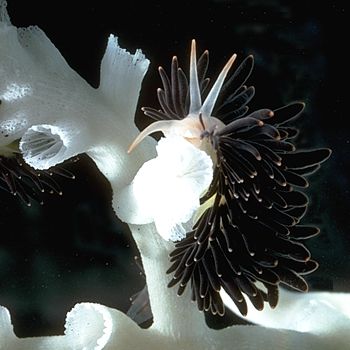
Phestilla melanobrachia
Bergh, 1874
Order: NUDIBRANCHIA
Suborder: AEOLIDINA
Family: Tergipedidae
PHOTO
Upper Right: On eaten colony of Tubastrea. Passe Deverd, outer Barrier Reef, near Koumac, New Caledonia, 20°44.7'S, 164°15.5'E, 15m, outside of reef, coral slabs, 13 October 1993, many specimens (20, 22 & 30mm, most 47mm long alive). Lower Left: egg masses laid on dead Tubastrea. AM C200460. Photos: Bill Rudman.
This relatively large aeolid (to 40mm long), has been recorded from southern Japan, and Hawaii, to northeastern Australia, suggesting a western Pacific distribution. It has both black and bright orange-yellow colour forms, the colour matching the colour of the dendrophylliid coral (Tubastrea, Dendrophyllia) on which specimens are feeding. Often mispelt melanobranchia, Bergh likening the cerata to 'arms' - brachia, rather than 'gills' - branchia.
References:
• Harris, L.G. (1968) Notes on the biology and distribution of the aeolid nudibranch (Gastropoda), Phestilla melanobrachia Bergh, 1874. Publications of the Seto Marine Biological Laboratory, 16: 193-198,2Pls.
• Harris, L.G. (1975) Studies on the life history of two coral-eating nudibranchs of the genus Phestilla. Biol. Bull., 149(3): 539-550.
• Rudman, W.B. (1981a) Further studies on the anatomy and ecology of opisthobranch molluscs feeding on the scleractinian coral Porites. Zoological Journal of the Linnean Society, 71: 373-412.
See Coral Feeding page for more information.
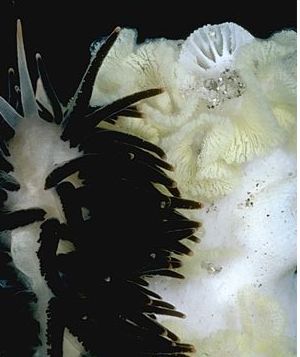

Rudman, W.B., 2001 (July 10) Phestilla melanobrachia Bergh, 1874. [In] Sea Slug Forum. Australian Museum, Sydney. Available from http://www.seaslugforum.net/find/phesmela
Related messages
Who can identify?
December 23, 2009
From: Carmen Obrist
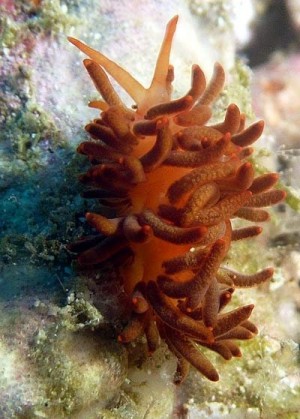
Is this a Tubastraea nudibranch?
Locality: Surin Islands, 20 metres, Thailand, Andaman Sea, 4 Feb 2009. Photographer: Carmen Obrist.
Carmen Obrist
carmen.obrist@qualidive.com
Obrist, C., 2009 (Dec 23) Who can identify?. [Message in] Sea Slug Forum. Australian Museum, Sydney. Available from http://www.seaslugforum.net/find/22995Dear Carmen,
This is Phestilla melanobrachia, which feeds on the coral Tubastraea
Best wishes,
Bill Rudman
Phestilla melanobrachia from Indonesia
November 25, 2009
From: Helene Caillaud

Hello,
Here is a picture of a nudibranch, that i'm trying to identify.
I'm hesitating between Phyllodesmium briareum or Phestilla melanobrachia. Could you help me to identify it
Locality: Bali, 20 metres, Indonesia, 8 october 2009, sandy area, muck dive. Length: 30 mm. Photographer: Helene Caillaud.
Thank you very much,
Helene,
from France
contact.helene.caillaud@gmail.com
Caillaud, H., 2009 (Nov 25) Phestilla melanobrachia from Indonesia. [Message in] Sea Slug Forum. Australian Museum, Sydney. Available from http://www.seaslugforum.net/find/22836
Dear Helene,
This is the black colour form of Phestilla melanobrachia which gave the species its name [melano = black]. I think the very blue look is caused by the way light is bent by the fine cilia on the cerata - you get a similar effect with black velvet cloth.
We usually think of this species as bright orange, but when they feed on the black form of the coral Tubastraea the digestive gland in their cerata fills up with black material. However, as we can see in the close-up, the orange pigment on the rhinophores and oral tentacles stays orange as it is based on skin pigment. As I discuss elsewhere on the forum [see coral feeding] species of Phestilla drop their cerata as a defensive strategy. In the close-up you can see two rows of small replacement cerata growing amongst the full size ones.
Best wishes,
Bill Rudman
Phestilla melanobrachia from Thailand, with parasites
February 9, 2009
From: Marcel Tanke
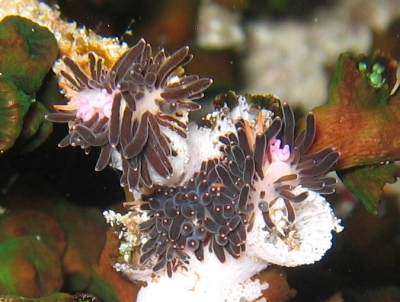
Concerning message #13183:
Hi Bill,
From Thailand, another record of Phestilla melanobrachia with parasitic eggs on their back. The picture shows 4 animals, one separate plus 3 in a group. The separate and the most right one have eggs on their back.
Locality: Simalan Islands, 22 meter, Thailand, Ademan Sea, 27 January 2009. Length: 1 cm. Photographer: Reinhold Mueller
Best regards,
Marcel
marceltanke@cs.com
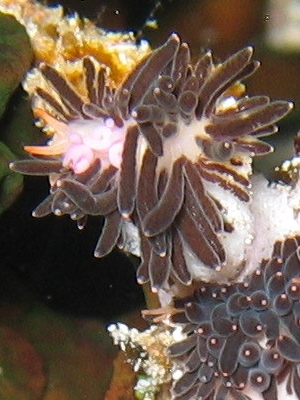
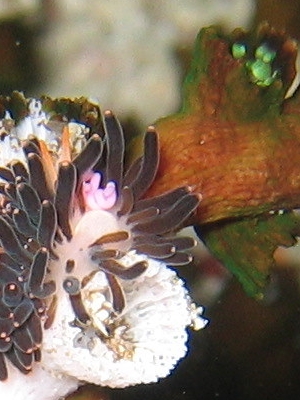
Dear Marcel,
I have included close-ups to show the egg masses more clearly. In the lower right photo we can also see where the Phestilla have been eating the coral colony. In the lower left corner of the photo we can see the bright white skeleton of the eaten part of the colony while at the upper right we can see a brown trunk-like part of the colony which is still covered by the brown living coral tissue which has not yet been scraped off by the Phestilla.
Best wishes,
Bill Rudman
Phestilla melanobrachia from sthn Queensland [2]
December 17, 2008
From: Gary Cobb
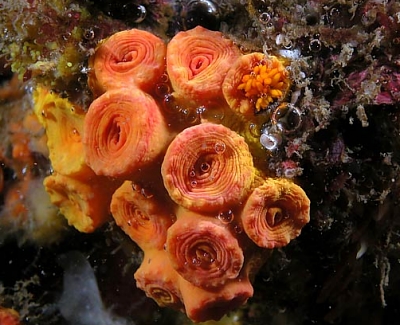
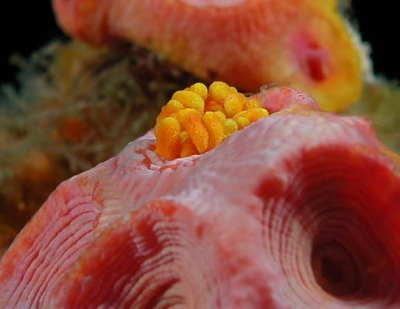
Hi Bill and everyone!
To accompany my other message [#22016] here are some more photos of Phestilla melanobrachia from sthrn Queensland.
The first two show an animal nestled in a polyp, and the lower one shows the four animals mentioned in my earlier message 'trailing'.
Locality: Mooloolaba, Sunshine Coast, 16 m, Queensland, Australia, Pacific Ocean, 26 April 2008, Subtidal. Length: 10-30 mm. Photographer: Gary Cobb and David Mullins.
Cheers
Gary
gary@nudibranch.com.au
Cobb, G.C., 2008 (Dec 17) Phestilla melanobrachia from sthn Queensland [2]. [Message in] Sea Slug Forum. Australian Museum, Sydney. Available from http://www.seaslugforum.net/find/22017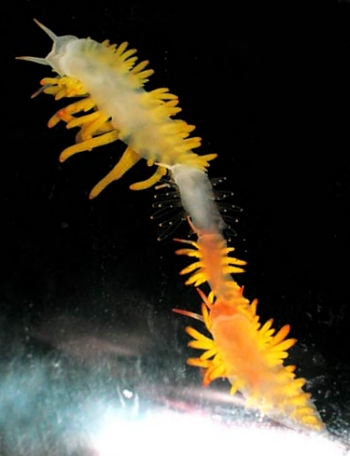
Thanks Gary,
Best wishes,
Bill Rudman
Phestilla melanobrachia? from sthn Queensland [1]
December 17, 2008
From: Gary Cobb
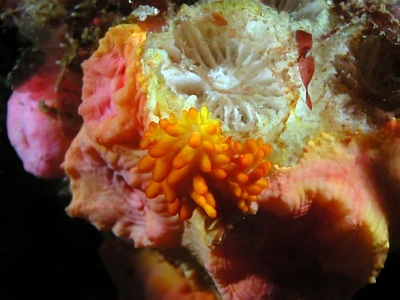
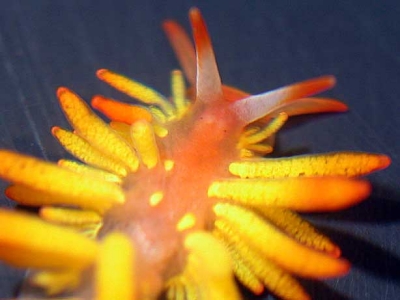
Hi Bill and everyone!
During our dives which happen almost every weekend we find many species of Opisthobranchs. One beautiful we see here is Phestilla melanobrachia. The orange and black colourforms. They are always found on Tubastrea sp. (daffodil or sunshine coral) it's food source. We sometimes find it on the substrate below overhangs were the coral lives. Where we think it has been knocked off. We also found the two colour forms on the same coral! One coral group yielded 4 animals, 3 orange and one black. On collecting them for study and taxonomic photos we noticed they love to trail each other! The largest one always in the front.
Locality: Mooloolaba, Sunshine Coast, 16m, Queensland, Australia, Pacific Ocean, 26 April 2008, Subtidal. Length: 10-30mm. Photographer: Gary Cobb and David Mullins.
Cheers
Gary
gary@nudibranch.com.au
Cobb, G.C., 2008 (Dec 17) Phestilla melanobrachia? from sthn Queensland [1]. [Message in] Sea Slug Forum. Australian Museum, Sydney. Available from http://www.seaslugforum.net/find/22016
Dear Gary,
Thanks for these observations and photos. Interestingly, I list two papers by Larry Harris on the species' Fact Sheet where he describes the behaviour of this species in Singapore and how they are usually found on broken off - but still live - pieces of Tubastrea found in the sand beneath overhanging colonies, exactly as you describe from sthn Queensland.
I would be interested in more observations on the colour forms and the corals they are living on. I have always assumed the colour forms would be found on corals of a matching colour, as the colour of the digestive gland is rather dependent on the food colour. If your animals are living on broken off fragments perhaps this means they have to change from one fragment to another as they eat it clean. If so, perhaps they change colour as they eat from a new fragment of a different colour. It would be interesting to hear of your observations on this point. Perhaps you have seen animals in the process of going from yellow to black or vice versa? Thanks also for the photos in your accompanying message [#22017].
Best wishes,
Bill Rudman
Phestilla melanobrachia? from Singapore
November 3, 2008
From: Toh Chay Hoon
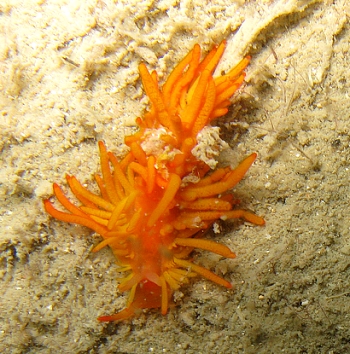
Concerning message #4768:
Dear Dr Bill,
I found this nudibranch on a silt-covered reef slope while diving at Pulau Hantu. Is this a colour variation of Phestilla melanobrachia?
Locality: Pulau Hantu, 10m, Singapore , South China Sea, 31 August 2008, Silt-covered reef slope. Length: 30mm. Photographer: Toh Chay Hoon.
Thank you,
Chay Hoon
sonnenflower@gmail.com
Toh C.H., 2008 (Nov 3) Phestilla melanobrachia? from Singapore. [Message in] Sea Slug Forum. Australian Museum, Sydney. Available from http://www.seaslugforum.net/find/22005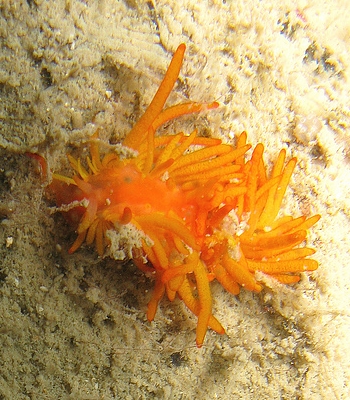
Dear Chay Hoon,
Yes this is the orange colour form of P. melanobrachia.
Best wishes,
Bill Rudman
Parasites on Phestilla melanobranchia
November 21, 2007
From: Jon Bertsch
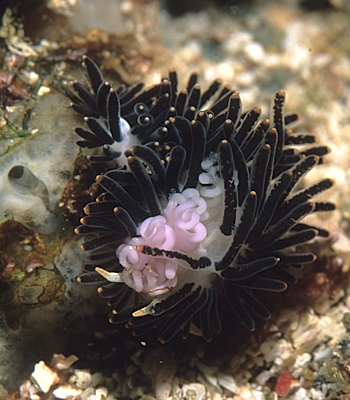
Hi,
Leslie Harris (I think that's the name) from the Natural History Museum of Los Angeles County suggested that I send this image of Phestilla melanobrachia to you as a second record to go along with a previous image [message #9871 ] showing internal parasites on the host.
Locality: Komodo National Park, 30ft, Indonesia, Flores Sea, Pacific Ocean, June 2004, Rocky reef. Length: 3 - 4 inches. Photographer: Jon Bertsch.
Regards
Jon Bertsch
jonti.bertsch@gmail.com
Bertsch, Jon, 2007 (Nov 21) Parasites on Phestilla melanobranchia. [Message in] Sea Slug Forum. Australian Museum, Sydney. Available from http://www.seaslugforum.net/find/21128Thanks Jon,
and thanks Leslie. The pinkish sausage-shaped objects are egg sacs of an internal copepod [crustacean] parasite. If you consider that every copepod has a pair of these egg sacs it means that this Phestilla is keeping about 20 copepods in food! Starving opisthobranchs usually reabsorb their gonads and reproductive system, so I suspect that if we dissected this animal we would find that its ovaries would be empty. It would be interesting to know if these parasitic infestations are permanent or temporary. Does the copepod live in the nudibranch producing eggs until the nudibranch dies, or does the copepod have a short lifecycle, dying in the nudibranch after producing one batch of eggs?
Best wishes,
Bill Rudman
Phestilla melanobrachia from Bali
August 8, 2007
From: Mike Krampf
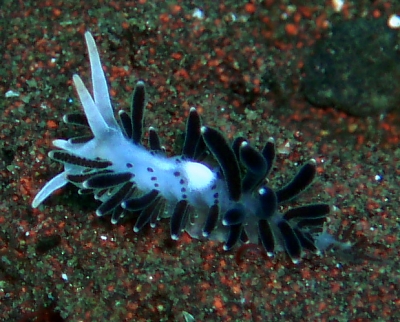
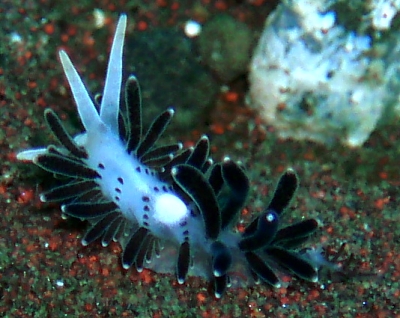
This is an interesting one that my dive buddy, Ernie Ismail, found while we were diving in Seraya Bay near Tulamben. Can you ID this one for me?
Locality: Seraya Bay, 40 ft, Tulamben Area, Bali, Indonesia, Java Sea, 27 July 2007, Black sandy area with scattered small coral patches. Length: 15 mm. Photographer: Mike Krampf.
Thanks,
Mike
mtkrampf@yahoo.com
Krampf, M., 2007 (Aug 8) Phestilla melanobrachia from Bali. [Message in] Sea Slug Forum. Australian Museum, Sydney. Available from http://www.seaslugforum.net/find/20365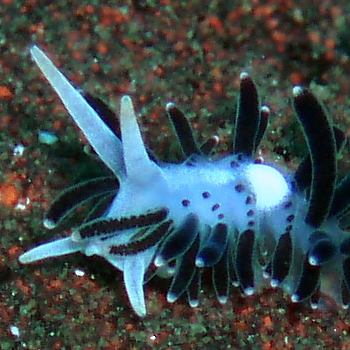
Dear Mike,
This is the black form of Phestilla melanobrachia. It is obviously been in an altercation with something because each black dot represents a lost ceras, or to be more positive, each black dot represents the bud of a new cerata. Like Phyllodesmium, species of Phestilla lack cnidosacs, the nematocysts of the corals they eat, obviously not up to the job of defending a nudibranch from predators. As you will see on the autotomy page, species of both these unrelated genera use their ability to drop off cerata as a defensive strategy, just like some lizards can drop their tails.
Best wishes,
Bill Rudman
Re: Phestilla melanobrachia from Hong Kong
July 25, 2007
From: Curt Swearingen
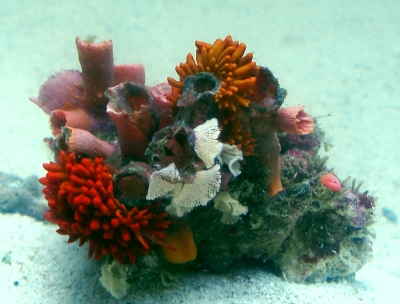
Concerning message #4811:
Thank you for this wonderful resource. I'm a reef aquarist and also manage a saltwater fish store. I got two of these in on some Tubastrea and I was able to ID these by your website.
Curt Swearingen
planetreef@gmail.com
Swearingen, C., 2007 (Jul 25) Re: Phestilla melanobrachia from Hong Kong. [Message in] Sea Slug Forum. Australian Museum, Sydney. Available from http://www.seaslugforum.net/find/20182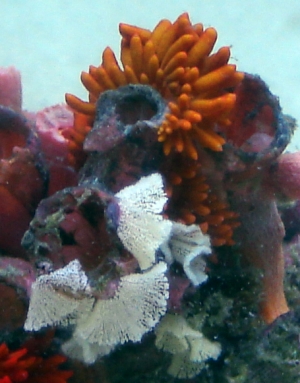
Dear Curt,
I am glad you find the Forum useful. Phestilla melanobrachia is one of very few nudibranchs which can be adequately maintained in aquaria - as long as you have supplies of living Tubastrea available. Unfortunately nudibranchs feeding on sponges, hydroids, bryozoans etc have very specialised diets, so we need to know that exact species they feed on. Even when we know their special food, the chances of having healthy and abundant supplies of it available to feed the nudibranch, are very slight
Best wishes,
Bill Rudman
Phestilla melanobrachia from the Red Sea
June 4, 2007
From: Sven Kahlbrock
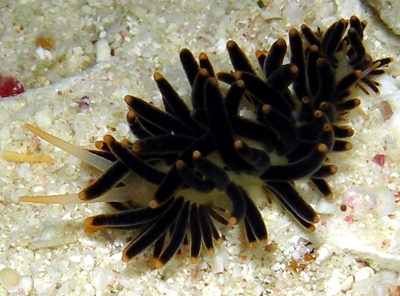
Hello Bill,
I found this in February - is it a kind of Flabellina?
Locality: el Fanadir Foc/ Hurghada, 14 m, Egypt, Red sea, 02 February 2007, sand bottom with some coral. Length: aprox. 3 cm. Photographer: Sven Kahlbrock.
with best regards,
Sven Kahlbrock
s_kahlbrock@web.de
Kahlbrock, S., 2007 (Jun 4) Phestilla melanobrachia from the Red Sea. [Message in] Sea Slug Forum. Australian Museum, Sydney. Available from http://www.seaslugforum.net/find/19460Dear Sven,
This is the coral-eating aeolid Phestilla melanobrachia. It usually feeds on Tubastrea and related corals and Larry Harris discovered that it was often more common on pieces of coral which had broken off the main colony and were lying on the sand underneath.
Best wishes,
Bill Rudman
Phestilla from the NOAA website
August 2, 2005
From: Frances Clements

Can anyone identify this sea slug? I was looking at the NOAA website [USA National Oceanic & Atmospheric Adminstration], of public domain pictures and thought this animal, probably from Hawaii, was very beautiful. Thanks for the information. http://www.photolib.noaa.gov/reef/reef0327.htm
Image ID: reef0327, The Coral Kingdom Collection
Location: University of Hawaii Institute of Marine Biology
Credit: Photo Collection of Dr. James P. McVey, NOAA Sea Grant Program
Frances Clements
:
frances@soulseedsvideos.com
Clements, Frances, 2005 (Aug 2) Phestilla from the NOAA website. [Message in] Sea Slug Forum. Australian Museum, Sydney. Available from http://www.seaslugforum.net/find/14461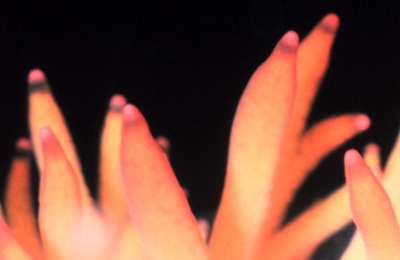
Dear Frances,
I am surprised NOAA haven't made some effort to identify their photos. This is the coral-eating Phestilla melanobrachia, an aeolid, which you'll see from the Fact Sheet, comes in orange and black colour forms.
Most aeolids have a cnidosac at the tips of their cerata where they store stinging cells from their prey. However, in the corallivorous genus Phestilla, the cnidosac is absent but the tips of the cerata are swollen, and the skin lined with large gland cells, which can be seen very clearly in the close-up of the photo alongside. Have a look at the pages on the Forum dealing with coral feeders.
Best wishes,
Bill Rudman
Phestilla melanobrachia with parasites
February 21, 2005
From: Roberto Sozzani
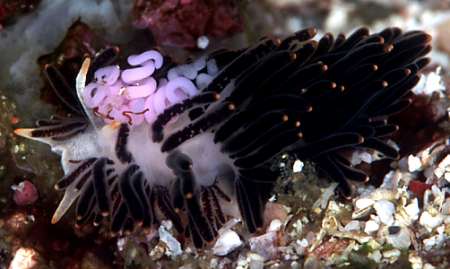
Dear Bill,
Your words "Although the name melanobrachia refers to the black form of this species...", in the message #13097, gave me the right hint to identify this specimen I photographed few years ago. There is a smaller one in the background. Both had many parasites.
Locality: Rinja Island, Indonesia. Depth: 12 metres. Length: 25 mm. June 2003. healthy coral reef. Photographer: Roberto Sozzani
Best wishes
Roberto Sozzani
www.robertosozzani.it
roberto.sozzani@fastwebnet.it
Sozzani, R., 2005 (Feb 21) Phestilla melanobrachia with parasites. [Message in] Sea Slug Forum. Australian Museum, Sydney. Available from http://www.seaslugforum.net/find/13183
Dear Roberto,
I'm glad my message triggered a memory. You'll notice in the black form the tips of the rhinophores, oral tentacles and cerata are yellow-orange, just like in the orange colour form. These animals are definitely heavily infested with some crustacean parasite, the pinkish curly structures being their egg masses.
Best wishes,
Bill Rudman
Phestilla melanobrachia from Reunion Island
February 19, 2005
From: Philibert Bidgrain
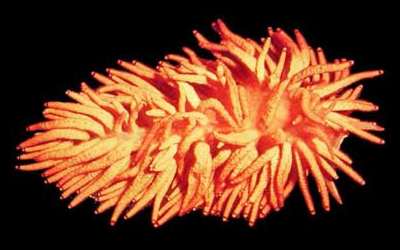
Dear Bill,
Reunion Island sea slugs.
We have only one specimen of Phestilla melanobrachia. It was observed by Maurice Jay. A few years ago. Photographer: Maurice Jay
Best Regards
Philibert Bidgrain
http://vieoceane.free.fr/runseaslug/indexslug.htm
pbidgrain@yahoo.fr
Bidgrain, P., 2005 (Feb 19) Phestilla melanobrachia from Reunion Island. [Message in] Sea Slug Forum. Australian Museum, Sydney. Available from http://www.seaslugforum.net/find/13097Dear Philibert,
Although the name melanobrachia refers to the black form of this species, this orange form seems to be the one most usually photographed.
Best wishes,
Bill Rudman
Phestilla melanobrachia from the Solomon Ids
July 21, 2004
From: Bruce Potter
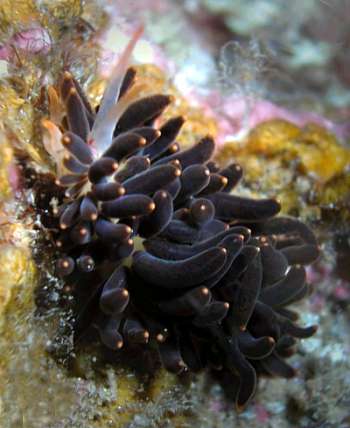
Dear Bill,
It was with great delight that I have observed the forum to be active again. I understand it will be in a reduced form temporarily, but even that is great.
I found the attached nudibranch on a night dive in May of this year on the site called Bonegi 2, just outside of Honiara, Solomon Islands. It was amongst the rubble at 12 meters. It was about 15mm long. I have not been able to find it in any of my books.
Can you help?
Regards
Bruce Potter
bac@solomon.com.sb
Potter, B., 2004 (Jul 21) Phestilla melanobrachia from the Solomon Ids. [Message in] Sea Slug Forum. Australian Museum, Sydney. Available from http://www.seaslugforum.net/find/12694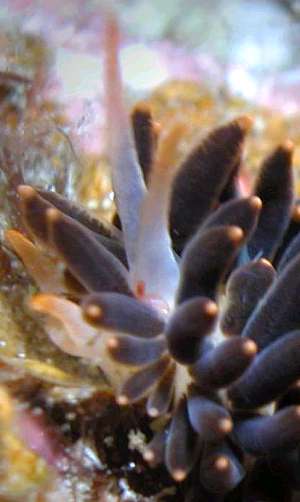
Dear Bruce,
Glad to be operating again - if at reduced capacity. This is the coral-eating aeolid Phestilla melanobrachia. As you will see from the Fact Sheet and my other comments this species comes in an orange and a black form and each form feeds on a similarly coloured form of the coral Tubastrea. From the close-up of part of your photo alongside you can see that there are orange markings on the body of this black animal, the black being confined to the digestive gland within the cerata. What we don't know is whether the color of the slugs is totally dependent on the colour of the coral they are eating. That is would a black Phestilla turn orange if it was feeding on an orange form of the coral?
Best wishes
Bill Rudman
Phestilla melanobrachia in East Pacific
September 6, 2003
From: Alicia Hermosillo
Dear Bill,
I am looking for Phestilla melanobranchia around here (Bahia de Banderas, Pacific Coast of Mexico), I have some evidence that even though it is an Indo Pacific species it might be found on our side.
One specimen of the species was found in La Paz many years ago.
A few days ago I heard of someone who had, SO VERY WRONGLY, collected a rock with Tubastrea coccinea for his aquarium (fact that I totally dissaprove of and even reported to the ecology offices) ... anyways, his "beloved piece" (meaning "his" coral, sorry, I do not like aquarists much) was slowly deteriorating and he told me that he saw the nudibranch that eats them one night.
Source of information aside, that is the second report I have heard of Phestilla melanobranchia being a nocturnal creature and the second report of the species in our Pacific. I have been able to find many other cryptic critters but not this one ... Do you (or anybody out there) have any information about its habits (nocturnal) or seasonality, even some searching tips for it that might help me find it? (Incidentally, I have the same problem with Phestilla lugubris though this one I have seen in Panama).
I appreciate your help
Alicia
gueri25@hotmail.com
Hermosillo, A., 2003 (Sep 6) Phestilla melanobrachia in East Pacific. [Message in] Sea Slug Forum. Australian Museum, Sydney. Available from http://www.seaslugforum.net/find/10858Dear Ali,
Firstly, its a common error to call this species melanobranchia [= black gills] when the correct spelling is melanobrachia [= black arms]. Larry Harris did a lot of work on Phestilla melanobrachia many years ago [see Fact Sheet for references] and as I discuss in an earlier message he found that it preferred, or at least was found most commonly, in broken off bits of Tubastraea lying on the substrate beneath large intact colonies. In general though, these large coral-eating species seem to be quite a catch for fish and you seldom find large animals in the field, and if you do they usually hide in crevices or under the base of the coral colony during the day. Although I sympathise with your feelings towards some aquariists, keeping some species in aquarium conditions is very useful. As I discovered many years ago, and aquariists have found out recently, a good way to find nudibranchs with specialist feeding habits is to keep the food in an aquarium for some time. If there is a nudibranch feeding on that particular colony - coral or soft coral - are two obvious choices, then they are able to grow without the danger of being picked off by fish. I was able to produce multiple generations of Phestilla lugubris, Phestilla minor and Cuthona poritophages by keeping small Porites colonies alive, in somewhat primitive aquarium conditions.
I suspect if you could find broken off pieces of Tubastraea it might be worth trying to keep them alive in an enclosed aquarium system. In this way if there are invisible juvenile nudibranchs present, thye ould have a chnace to grow to visible size.
Concerning Phestilla lugubris in Panama. I described some specimens of Phestilla from Panama as a new species Phestilla panamaensis. My argument was that its radular morphology was, in my opinion, rather different from the radula of Phestilla lugubris which was a constant shape from east Africa to eastern Australia. Terry Gosliner is of the opinion that it is just Phestilla lugubris. I suspect we will need to learn a lot more about their repective biologies, and perhaps their DNA before we can be sure one way or the other.
Best wishes,
Bill Rudman
Phestilla melanobrachia & parasites
May 12, 2003
From: Lisa Malachowsky
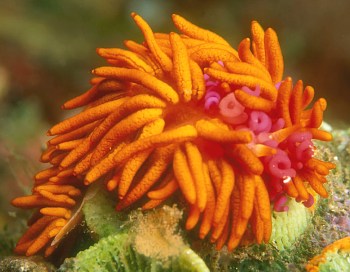
This is a picture that my partner Sharron took while we were in Alor, Indonesia this year in February (2003). I think the slug is Phestilla melanobrachia. I'm trying to confirm if the spiral purple "thingies" on its back are eggs or if this nudi is some other species.
Any ideas?
Lisa Malachowsky
grrldive@pacbell.net
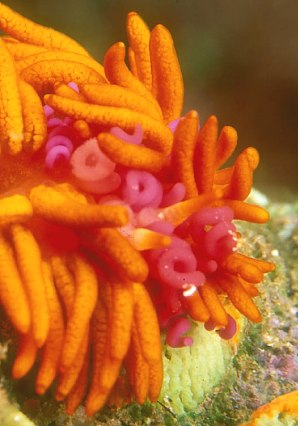
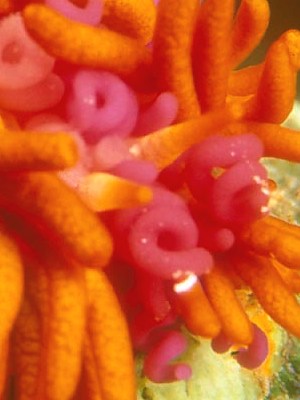
Dear Lisa,
Your animal is the coral-feeder Phestilla melanobrachia, but unfortunately for the slug the 'spiral purple thingies' are not part of it. They are the eggs of parasites - probably a parasitic copepod which is living inside the body and poking the eggs out so the larvae can escape when they hatch.
A rather spectacular example.
Best wishes,
Bill Rudman
Phestilla melanobrachia from Myanmar
March 25, 2003
From: Mary Jane Adams
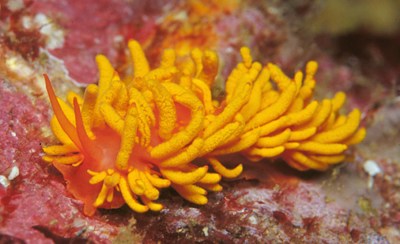
Hi Bill,
I found this Phestilla melanobrachia in the Andaman Sea in southern Myanmar. It was sitting at the base of the central pinnacle at Three Islets on Feb.14, 2003. It was 21mm long and the depth was 12 meters. There is a lot of both orange and green Tubastrea coral on this reef. Mark Strickland told me the orange form of these slugs is seen occasionally in this area.
Best regards,
Mary Jane Adams
divepng@yahoo.com
Adams, M.J., 2003 (Mar 25) Phestilla melanobrachia from Myanmar. [Message in] Sea Slug Forum. Australian Museum, Sydney. Available from http://www.seaslugforum.net/find/9404Thanks Mary Jane,
When Larry Harris first studied this species, he found that the best place to find animals was not on the intact coral colonies, but on the substrate under overhangs where pieces of broken off, but still living, coral were lying. Perhaps this gives the Phestilla a better chance to hide from predators - amongst the coral rubble.
Best wishes,
Bill Rudman
Phestilla melanobrachia from Malaysia
April 18, 2002
From: Kheong Sann Chan
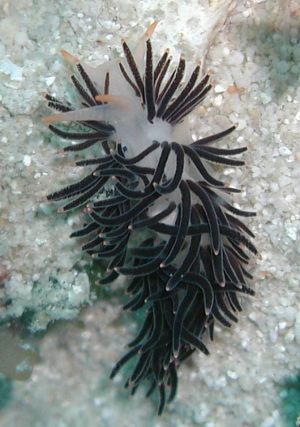
Hi Dr. Rudman,
I am just a casual diver/photographer, and recently snapped a lot of really colourful nudibranchs at Pulau Dayang off the East Coast of Malaysia. Depth varied approximately 15-23m deep. I don't have any knowledge of nudibranches and the like, but after having seen so many, I thought I'd drop by your page and see if I could identify them. I didn't even make it through 10% of your species list though ... I thought I'd send you some of the photos and if you happen to know or recognize any of them, then perhaps you could just tell me about them, or point me to where I can dig up more information on them. This one was photographed on the 13 April 2002.
Kheong.
kschan@mail.dsi.nus.edu.sg
Sann Chan, K., 2002 (Apr 18) Phestilla melanobrachia from Malaysia. [Message in] Sea Slug Forum. Australian Museum, Sydney. Available from http://www.seaslugforum.net/find/6749Dear Kheong,
Thanks for this and the other photos which I'll post over the next few days. This is a coral-feeding aeolid, Phestilla melanobrachia which has two colour forms, one black, the other bright yellow orange, depending on whether it feeds on a black or orange corals dendrophylliid coral. Larry Harris reported many years ago that this aeolid seem to prefer feeding on pieces of coral that had broken off and were lying on the bottom below the main colony. If you are unfamiliar with the Forum, each species has a Fact Sheet and all the relevant messages are attached in chronological order below, so make sure to look above and below your message for more infomation. Also have a look at the Coral-Feeding page which will give you an index to other relevant pages.
Best wishes,
Bill Rudman
Phestilla melanobrachia from Hong Kong
July 17, 2001
From: Leslie Chan
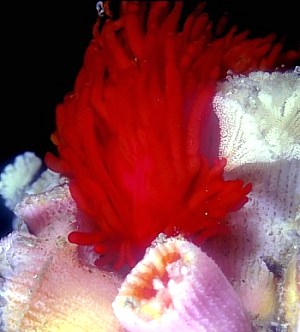
Dear Bill,
Could you identify this nudibranch which I photographed in Hong Kong.
Details: 15m, Ninepin Group, Hong Kong. 15 December 2000.
Thanks
Leslie Chan
leslie@lesmart.com
Chan, L., 2001 (Jul 17) Phestilla melanobrachia from Hong Kong. [Message in] Sea Slug Forum. Australian Museum, Sydney. Available from http://www.seaslugforum.net/find/4768Dear Leslie,
This is Phestilla melanobrachia. It feeds exclusively on the corals Dendrophyllia and Tubastrea, usually preferring detached pieces of living coral. It has two colour forms, one bright orange, the other black, matching the two colour forms of the coral on which it feeds. In your photo most of the coral tissue has been removed from the skeleton. At top right, the small white dots are its eggs, which are deposited in dorid-like egg ribbons.
Best wishes,
Bill Rudman
Phestilla melanobrachia from Hong Kong
July 17, 2001
From: Bill Rudman & Brian Darvell
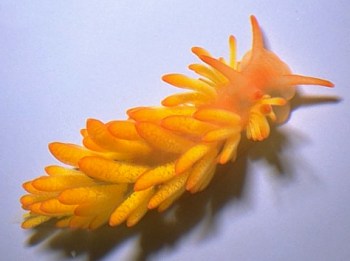
To accompany Leslie Chan's photo, here is the single record of Phestilla melanobrachia from Brian Darvell's Hong Kong collections. It is the orange-yellow colour form.
PHOTO: Tan Pai, Hong Kong, 20 Jan 1985, 17m, HK183/1, AM C145294
Best wishes,
Bill Rudman & Brian Darvell
